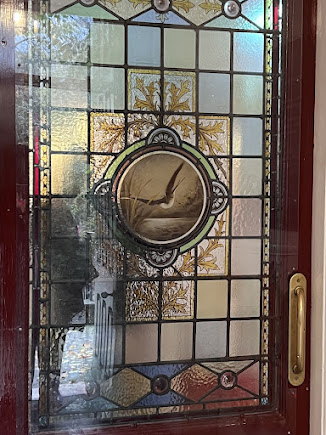The museum opened in the 1980s, and focuses on the history of the Erewash area, with exhibits covering the Second World War, archaeology, and the Stanton Ironworks. The building that houses the museum is named the Dalby House after one of the families who inhabited it, and has served as a school and a private dwelling.
And so on November 22nd, we travelled to Ilkeston to take a look around the Museum to help gather some inspiration for our own works that will be exhibited in one of the rooms there.
To get to the museum, we walked through High Street, which showed us Ilkeston's different types of architecture on the buildings and churches. We also took pictures of the areas around us that we liked so that it would give us some inspiration for our works that we would be putting on display.
(part of the kitchen area)
Men between 18 and 41 were called up as soon as war was declared. By the end of the war conscription had widened to include men up to 51 and women between 20 and 30.
Air Raids
The summer of 1940 saw Germany bomb targets across Britain. The plan was to weaken Britain to the point where the German military could carry out a full invasion.
The Royal Air Force successfully defended Britain and no invasion took place. However, cities across the country suffered terrible damage and many thousands of people died.
Bombs were dropped in this area on 27th - 31st August, the 4th September and 30th September.
Stanton Ironworks was the main target because of the important work being carried out there but residential areas such as Shipley and Sawley were hit.
Thankfully there were no reported deaths, but there was much damage to property.'
The Stanton Ironworks Company, later called Stanton and Staveley, Invested in local young people by laking on apprentices. In 1947 the Training Centre was opened.
Trainees would usually spend six months there before moving to the ironworks. One day per week would also be spent at the Ilkeston College of Further Education learing theory.
In the 1960s boys were encouraged to spend a month in the Lake District climbing, swimming, and sailing, in the hope that it would develop leadership skills and produce well-rounded employees.
The work was hard and often dangerous but the ironworks offered young people a chance to gain employment and learn skills. Many started out as apprentices in their teens and stayed at Stanton for all of their working lives. It was common for several generations of one family to be working at the Ironworks at the same time. Skills and knowledge were passed down helping to build a legacy of community and family at Stanton.
Gold watches were presented to long serving employees. 30 years' service for male workers and 25 years service for female workers, By the1960s over 3500 gold watches had been given by the company.












No comments:
Post a Comment